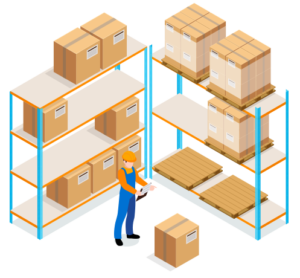It’s needless to say that eCommerce has made shopping swift, simple, and convenient. Products round-the-world are now just a click away and can be accessed from the comfort of one’s home. But what happens at the backend of an eCommerce store, from the time an order is placed to when it is successfully delivered?
There are a lot of logistics involved in giving a seamless shopping experience to a customer. An eCommerce store owner has to ensure that products reach customers safely and on time. An order management system helps in facilitating the flawless management of customer orders and delivery.
In this article we’ll cover:
- What is an Order Management System?
- Functions of an Order Management System for eCommerce
- How to Choose the Best Order Management System eCommerce
What is an Order Management System?
Whenever a customer places an order on your store, the following activities and logistics need to be taken care of from the backend of your store:
- Your store needs to accept orders and process payments
- Update the accounting system, generate invoices, look after account payables and account receivables
- Assign a warehouse the responsibility to deliver based on the location and proximity of the customer
- Provide order details to warehouses
- Update inventory levels across different sales channels
- Track order for customers and customer service teams
- Forecast stock levels based on current order frequency to avoid shortage in the future
All the above activities are tracked and taken care of by an order management system. An OMS will give you a centralized platform to keep an eye inventory, orders, sales, and fulfillment.
The following are some of the tasks an OMS performs:
Functions of an Order Management System for eCommerce
1. Order Tracking
Order management systems keep a track of all your orders across channels- website, phones, or in-person. You’ll be able to access order details and its status from anywhere as your OMS will centralize the entire process.
Your OMS will also track all pending orders for your customers and customer service teams. It will keep updating them on the order status so that they always know which at stage of order fulfillment their purchased item is.
2. Locating inventory

More than 43% of retailers say that inventory management is their biggest challenge. This is because keeping a track of products going out and coming in, correctly updating the systems, and managing inventory across different locations can be complicated and confusing.
Improper management can lead to shortages and delayed fulfillment, eventually compounding into revenue losses.
An order management system simplifies and centralizes this process by using practices like item-level tagging, RFID technology, and automated inventory management.
3. Order fulfillment
Online shoppers are generally willing to wait for 1-2 days to receive orders or 2+ days if the shipping cost is free. Delivery speed obviously plays a big role in determining a store’s revenue and sales.
You can only maintain fast and consistent delivery if you assign warehouses that are nearest to the customers. Your order management system can help you assign the right warehouses depending on inventory availability, and also ensure orders are packed and shipped with correct shipping labels.
4. Manage order returns
Customers return their orders often in eCommerce. Keeping a track of return orders, updating inventory, returning money, updating sales and revenue records, etc can be tricky.
An OMS can help eCommerce shops see hand processing of returns and refunds.
5. Multichannel integration
You can manage sales from across all channels in your order management system, thereby centralizing the entire procedure and minimizing duplication errors. An OMS will help you keep an eagle’s eye on all your sales records, helping you sell and fulfill orders with more accuracy
How to Choose the Best Order Management System eCommerce
1. Integration
Your OMS should integrate with your eCommerce platform seamlessly, and you shouldn’t have to alter your website’s backend structure just to fit in the OMS. Most order management systems designed in a way that they can be easily integrated with all eCommerce platforms out there.
2. Supplier consideration
Your OMS should make the process of purchasing your products from suppliers easier. Complex supply chain procedures should be simplified, and your inventory and records should be updated easily after products have been received.
3. 3PL, warehouse, and fulfillment integration
Most eCommerce stores outsource warehouses, shipping, and fulfillment. An OMS has to work with the people who pack, ship, and deliver your order. It should check for orders frequently and effortlessly send them to warehouses or 3PLs for fulfillment.
4. Scalability
As an eCommerce company grows, its sales, suppliers, need for inventory, sales channels, etc grow with it.
An OMS system should be able to handle all these aspects if your online store is to grow in size. It is important to determine what functionality your business needs now and could need in the future. A lot of order management systems have limitations and don’t offer all the features a large business would need, so weigh your options wisely.
5. API
All businesses have different management requirements. While all OMS will provide you with most functions, there still might be a few operations you’d need to add on your own. Check if your OMS gives you access to their API so that you can improve the system and tweak it for your benefit.
6. Reporting & forecasting
Apart from sending through orders and updating information, an OMS should be able to report the trend in your sales and revenue. It should forecast and identify issues that you could face (such as stock shortage), so that you’re able to plan for those issues ahead of time.
7. Automation
The entire point of getting an OMS is to automate mundane and tedious order management tasks so that you can concentrate on growing your business. An OMS automates manual tasks such as sending orders to warehouses, updating sales reports, generating invoices, tracking orders, etc.
It’s advisable to go through your OMS’s catalog properly and assess how many tasks are being automated and how many will have to be done manually.
8. Customer-centric functionalities
A lot of e-stores cater to customers across the globe, so clearly there will be differences in language, taxation procedure, currency, etc. An OMS can minimize the difficulty in managing all these differences and support all language, currencies, etc to provide a better customer experience.
Conclusion
Choosing the best order management system eCommerce can be a tough task and it must not be taken lightly if you don’t want to lose revenue due to inventory stock-outs, delayed delivery, etc. Just understand the criteria properly, list down your priorities, and choose accordingly.
If you have any queries or feedback, do let us know in the comments below!
Interesting read: Stripe Vs Razorpay: 5 Differences you Need to Know

Divya loves writing and is passionate about marketing. When not trying to hone her skills, you’ll find her either reading or binging on TV shows.

0 Comments